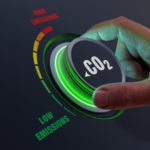News - Construction News
Five ways to reduce emissions in the built environment

Approximately 13 percent of the UK’s greenhouse gas emissions are generated by the heating and cooling systems within our homes. This is partly because, in the UK, most houses still utilise traditional gas boilers and many older homes have not yet been upgraded with more effective insulation.
Housebuilders across Europe, the US and China are further ahead than those in the UK when it comes to the adoption and installation of more efficient heating and cooling technology, with 60 percent of Norwegian homes utilising heat pumps, for example. With the goal of net zero by 2050 fast approaching, it is critical that Britain’s construction industry finds ways to minimise the impact of domestic heating and cooling systems on the environment, but why has it been slow to adopt new technology?
One factor is the cost of implementing changes. Purchasing and installing an air source heat pump can cost upwards of ten thousand pounds – something that many UK homeowners are simply unable to afford, particularly as the cost-of-living crisis continues to take its toll. Whilst funding is available through the Government’s boiler upgrade scheme, it is not enough to allow homeowners to upgrade their heating and cooling systems without using a large portion of their savings, or simply too costly to be viable.

Mark Sugden

Joanna Thurston
Another potential roadblock to the wider adoption of heat pumps in the UK is the skills gap. Innovators have been continuing to refine and enhance heat pump design – for example, Mitsubishi’s recent UK patent GB2561098 that provides a new way to manufacture U-bend pipes for heat exchangers to address issues of connectivity. However, without trained workers to install the systems, take-up amongst the public will remain low.
Alongside the lack of skilled installers, there are further challenges for innovators to solve. Whilst heat pumps are energy efficient, issues such as noise, size and range need improvement. For example, the size of a typical heat pump means that it is unsuited for use in an apartment. There are also questions around ensuring that this technology has the power required to heat older homes, as well as the ability to function efficiently at lower temperatures.
However, it is not only heat pumps that innovators need to focus on to reduce household emissions across the built environment in time for 2050. The construction industry has been implementing changes and innovating at pace, for example by improving waste reduction and encouraging the reuse and recycling of building materials. Utilities & Civils Solutions has recently been granted a UK Patent (GB200448B) that incorporates waste tyres as an aggregate material in concrete. Many construction companies are also innovating within the early planning phase, using building information modelling (BIM) to optimise use of energy-intensive materials such as steel. This modelling can also be used to assess the lifecycle carbon emissions of various materials, allowing for low carbon alternatives to be selected where possible.
Modern methods of construction (MMC) also have a role to play, with offsite construction methods offering another means of reducing carbon emissions through use of low-carbon manufacturing processes and precision manufacturing to reduce waste.
With so much scope for innovation, here are some emerging patented technologies to watch:
- The first comes in the form of building integrated photovoltaics (BIPV): advanced solar technology that is often incorporated into roof tiles to maximise efficiency. Dutch company, Exasun, provides an example of this with their patented technology for roof tile elements (EP4272308A1). Using solar technology in this way makes it accessible and easy to install, which should help to encourage take up.
- Another innovative solar solution utilises perovskite solar cells. This type of solar technology has gained significant attention in recent years, due to its potential for high efficiency energy generation at a lower cost than traditional silicon-based cells. It can be manufactured using simpler processes, such as printing, and can be made semi-transparent or in different colours, offering additional application possibilities. Its flexibility and lightweight properties make these cells suitable for a variety of applications. Recent research by scientists at the University of Swansea has found a means of rolling solar cells so that they can be wrapped around irregular areas (GB202218561D0).
- Heating, ventilation and air conditioning (HVAC) systems are a focus for innovation – particularly involving use of AI management systems. For example, Brainbox AI has patented technology for an AI-led HVAC system management solution (US20210003308A1). This technology uses deep learning, cloud-based computing and proprietary algorithms to autonomously optimise a building’s existing HVAC system, providing up to a 40% reduction in carbon emissions and a decrease in HVAC-related energy costs of up to 25%.
- Johnson Controls has been similarly active in filing patents related to AI-controlled HVAC and other energy optimisation innovations. They have recently been granted a US Patent (US17/685,750) directed to a building management system that includes a machine learning engine in the cloud. The system involves a controller for an HVAC device that communicates with field devices and the cloud service, transmitting and receiving data to optimise control logic based on the identifying characteristics of connected devices.
- A final area of innovation to watch is that of energy storage solutions. The switch to renewable energy will require energy to be stored on an unprecedented scale, and the race is on to find an efficient and effective method of storage for residential homes. One proposed solution is that of a ‘salt battery’ capable of thermochemical energy storage (CA3207996A1), currently being developed by a spinout from the Eindhoven University of Technology, Cellcius.
As net zero approaches, innovation will increase and intellectual property rights (IP) should be secured as soon as possible to protect them from being copied and to secure their commercial potential. Those innovators that are first to market with products that can reduce carbon emissions in the built environment could become standard essential in the future. Innovators should seek external advice where necessary to ensure that their products or systems stand the best chance of commercial success, improving the built environment and securing the long-term health of the planet as they do so.
Mark Sugden, partner, and Joanna Thurston, partner, at European intellectual property firm, Withers & Rogers.
If you would like to read more stories like this, then please click here
Related Articles
More News
- UK Introduces New Trade Measures to Support Steel Sector
11 Jul 25
Steel producers across the UK will benefit from stronger trade measures from 1 July.
- Clean energy future to be ‘built in Britain’
10 Jul 25
The Clean Energy Industries Sector Plan comes into force to ‘build it in Britain’.
- Thousands more to get the tools they need to start construction careers
9 Jul 25
Thousands of people are set to benefit from on-the-job training and career opportunities in the






